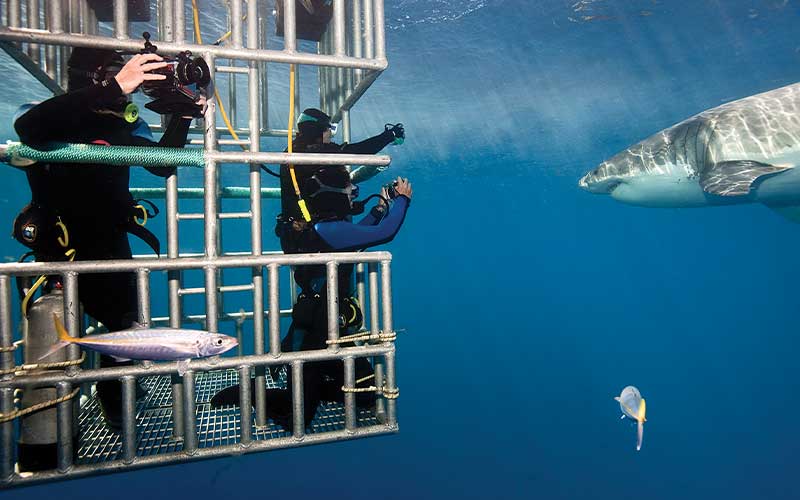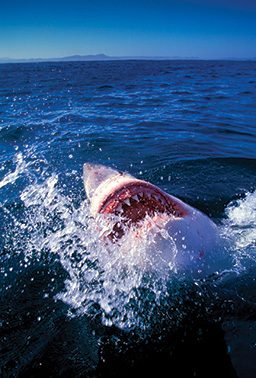The great white shark can be confused with no other fish. You’ll immediately notice the counter-shading of gray above and white below, the black seemingly empty eyes, the impressive girth and of course, the teeth — the very serious, serrated, triangular teeth.
For most underwater photographers, the great white shark is a definite Bucket-Lister, a species that must be added to one’s portfolio. In addition to the significant great white shark encounters found at the Neptune Islands off South Australia, there are two other iconic hotspots for great white photo-ops: Guadalupe Island, Mexico, and Dyer Island, South Africa. While each destination offers reliable white shark opportunities, they offer very different shooting challenges.

Guadalupe
An impressive white shark population is found around the island from August through November, which also happens to be the ideal season to make the 22-hour liveaboard crossing from Ensenada, Baja California. In addition to easy access for North Americans (at least in comparison to other white shark encounters), Guadalupe offers spectacular water clarity and sharks accustomed to being around the cages.

Sharks will arrive at the stern shortly after the boat anchors, and they will remain nearby for the entire three- to five-day cruise. This is not to imply that sharks will be at the cages the whole time, for white sharking requires patience and a bit of luck. The popularity of the adventure means there will inevitably be multiple boats on location, each trying to entice Carcharodon carcharias close to their cages. Given a finite number of sharks, the competition is sometimes a hassle, but rarely does a day go by without significant photo opportunities. The trick is to be in the water and in the correct part of the cage when a shark makes a dramatic appearance.
South Africa

Both casual day-trippers out of Capetown and serious marine photographers flock to the fishing village of Gansbaai on the Western Cape of South Africa to see the great white sharks at Dyer Island. Located just six miles offshore, it can be a very long six miles when the winds are howling and the seas are raging. Dyer Island and nearby Geyser Rock are home to some 50,000 Cape fur seals, which is why white sharks are found here year-round, generally in the channel separating the two islands. Sometimes there are more boats than there are sharks, and getting the sharks close to the boat requires a combination of good chum, a savvy wrangler and sometimes a bit of luck in terms of anchoring where the prevailing currents create an optimal chum slick.
The most talented of the shark wranglers are able to finesse the whites right up to the swim platform or cage with a combination of bait, blood and often a decoy cut in the shape of a sea lion. The white sharks here are also well known for their breaching behavior (it typically occurs in the early morning and at dusk), which presents the opportunity to get above-water shots of the sharks savaging the bait. Another classic shot from Gansbaai is “jawing,” where a skilled wrangler puts a hand on the nose of a white shark at the surface, stimulating a nerve cluster that causes the shark to arch backward with mouth agape. Photographers will find the best overall conditions between the end of May and the end of September, with June and July typically considered primetime. It should be noted that good visiblity, by Gansbaai standards is 15 to 20 feet of green water. Underwater shooting opportunities are best when the sharks pass very close to the cages.
Photographic Variables
Regardless of the location, shooting great whites requires a few specialized photo techniques.
Strobe vs. available light: Most underwater white shark encounters happen from cages deployed near the boat, close to the surface; the deep cages of South Australia being the exception. With so much ambient light, and given the tight confines of a shark cage, many shooters opt to forgo strobes. This is especially so in South Africa, where the water is typically turbid and backscatter often inevitable. Even in clear water, getting the shark close to the dome requires artful baiting and a chum slick, all of which can create annoying detritus when lit with a strobe. Despite all that, I like using strobe light because it accents the teeth, arguably the most important detail in a white shark photo. The eyes of a great white shark are black and almost featureless, but a little strobe can bring out surprising detail. About the only time I don’t use a strobe with white sharks is when I’m shooting over/unders, and even then I may use a single small strobe on the underwater portion of the composition. I like to be able to define the white belly and jaw area of a great white shark, and without a strobe those all-important features can turn out flat and gray.
It doesn’t take a lot of light. I generally shoot in fully manual mode with my strobe set at quarter-power for a shark that is making close passes, or half-power for one a bit more reticent and distant. A shark 5 to 6 feet away will get a full-power dose of strobe. Because shark action happens fast, a strobe that offers quick recycle characteristics is a must. If strobes are used in a multi-shooter cage, it is more courteous to use a single strobe and single arm rather than an unwieldy double-strobe configuration.

Preferred lens options: Great white shark photography requires wide-angle lenses; how wide will depend on how close the sharks are likely to get. Remember these are big animals, 12 to 16 feet in length, and sometimes they will come right up to the bars of the cage. For cropped sensor Nikon cameras, something like a 12-24 zoom is ideal. I shoot a full-frame Canon (either a 1DsMKIII or a 5DII), and my go-to lens for shark photography is my 16-35mm II zoom. If I am having extraordinarily close passes, I’ll go to my 14mm rectilinear or even my 15mm full-frame fisheye, assuming I am able to fill the frame and force the perspective to make a large shark appear even more magnificent and menacing. Because I’m using wide glass, my strobes will always have a diffuser to spread and soften the beam.
Topside shots: Capturing topside shots in South Africa requires a fast motor drive, a short telephoto zoom and at times, the benefit of strobe fill light. Given the unpredictability of white shark action, keep one camera dedicated to topside use.
Finding a Unique Perspective
For many years, just getting a properly exposed “fish ID” shot of a great white shark was good enough. Now, with such easy access to reliable white shark encounters, rising above mediocrity requires extra creativity. Here are a few bar-raisers you might consider:

Go for the teeth: No matter how creative your lighting, you won’t read much expression from the charcoal pit of a shark’s eye. Teeth are the differentiator. The familiar serrated triangle of the white shark dentition is both biological identifier and an atavistic fear. The close-focus, wide-angle shot of the enormous maw of a great white shark near the bait is the money shot, and if the wrangler can get the open mouth without the bait visible, all the better.
Consider black and white: Sharks are typically monochromatic and make spectacular subjects for black-and-white images. For digital photographers, elegant black-and-whites can be created with the click of a mouse and a few slider controls in Adobe Lightroom. When working from “virtual” copies another instruction set is applied to the image rather than dedicating the hard-drive space to a new black-and-white high-res file.
Try over/unders: Some of the more dramatic shark images are captured with the camera half in and half out of the water, although this can be risky. Once in South Africa I was lying on the swim platform trying for over/unders when a curious shark actually rammed his snout into my dome, smashing the housing into my forehead. I got a nasty bruise but felt fortunate when I realized the shark could easily have taken my head. Older and wiser now, I find the better solution to be a polecam. A remotely triggered camera can be lowered into the midst of a feeding frenzy. I like this option not only for safety but also for extreme proximity. It also prevents the sharks from breaking their teeth off on the cage with an overly aggressive approach.
© Alert Diver — Q1 Winter 2010